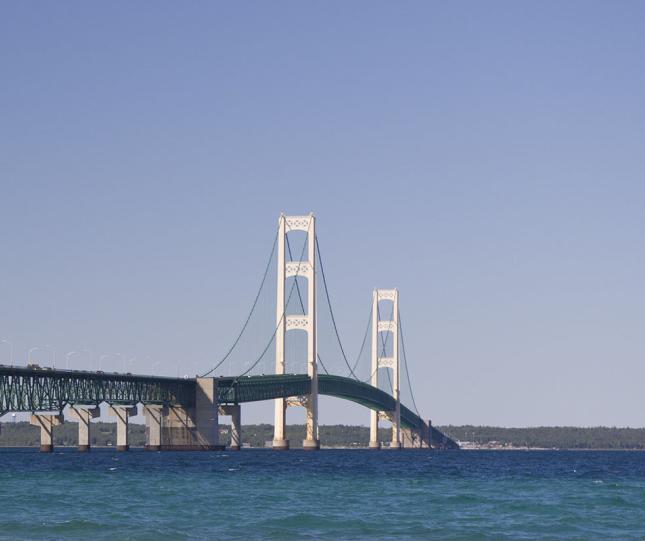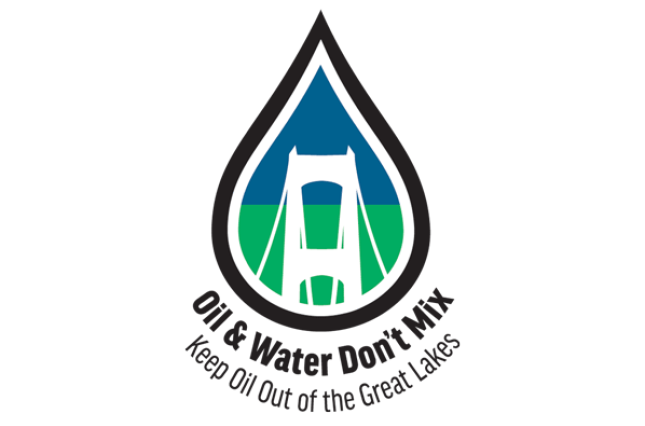A fossil fuel pipeline exists at the interaction of two Great Lakes. Built for 50 years but running for over 70. Unsupported sections, a million gallons already spilled along its length, owned by a company responsible for the largest inland oil spill in US history. The aging Line 5 pipeline is a disaster waiting to happen. This is a timeline of major Line 5 events, from construction in 1953 to present day.
Download A Printable PDF Of This Timeline

April 23, 1953
Lakehead Pipeline Company, Enbridge’s predecessor, was granted an easement by the Conservation Commission of the State of Michigan to construct and operate an oil and gas pipeline on the bottomlands of the Straits of Mackinac. This easement was void from its inception due to the state never making a finding that the easement could be made without harming public trust resources.

1963
The first evidence of non-compliance by Enbridge with their easement to operate Line 5 is from 1963. Enbridge agreed to anchor the pipeline to the lakebed with grout bags at least every 75 feet. In 1963, there were 17 spans larger than 75 feet detected and Enbridge took no action to fix this problem, even though it put the Great Lakes at greater risk and violated their agreement with Michigan. Since 1963, Enbridge has never been in compliance with the easement.

1968
In the first documented Line 5 oil spill, over 285,000 gallons spilled near Gogebic, MI. This would be the first of over 30 Line 5 oil spills to date, totalling over 1.1 million gallons of oil spilled. Click here for full interactive map.

1972
A longitudinal weld failure caused another large Line 5 oil spill near Iron River, MI. This time totalling 252,000 gallons. The resulting fire injured two people.

1976
Another Line 5 oil spill near Gogebic released 210,000 gallons, injuring two more people.

1992
17 additional unsupported spans of pipeline were identified in the Straits of Mackinac. Four of them exceeded 200 feet, with the longest being 359 feet. Unsupported spans of over 200 feet reach the tensile strength of the steel used in building the pipeline, likely causing new bends in the pipeline.

1997
45 new unsupported spans were identified in the Straits, with the longest being 421 feet. No action was taken to support the pipeline.

1999
A major Line 5 spill of natural gas liquids occurred near Crystal Falls, MI. The 226,000 gallon spill caused 500 people to be evacuated. The ensuing fire raged for 36 hours.

July 25, 2010
Enbridge Line 6B spilled over 1 million gallons of heavy crude into Talmadge Creek, which polluted the Kalamazoo River in one of the largest inland oil spills in US history. Weeks before, Enbridge had assured federal regulators that Line 6B was in excellent condition.

2013
University of Michigan experts identify the Straits of Mackinac as the worst place in the Great Lakes for an oil spill. Download the full report from the Graham Sustainability Institute here.

2015
Governor Rick Snyder established the Michigan Pipeline Safety Advisory Board (PSAB). An overwhelming majority of PSAB board members were oil industry insiders, including Enbridge officials. After three years of meetings and releasing several dubious Enbridge-funded reports, this board paved the way for Enbridge’s Line 5 tunnel scheme.

April 1, 2018
A vessel anchor strikes Line 5 in the Straits of Mackinac, caused three large gouges in the pipeline. Enbridge control systems didn’t detect the anchor strike, and despite not having video evidence of the pipeline’s condition for over two weeks, Enbridge never shut the pipeline down. Watch a video of the anchor damage here.

October 2018
Governor Snyder’s preliminary tunnel agreement with Enbridge was publicly released.

November 2018
A bill was introduced in the lame duck session of the Michigan Legislature in an attempt to protect the tunnel scheme before Governor Gretchen Whitmer and Attorney General Dana Nessel were sworn into office.

December 2018
A lame duck legislature passed SB 1197 to create the Mackinac Straits Corridor Authority and pave the way for the oil tunnel. The newly assembled three member board signed three new agreements with Enbridge by December 31st, one of them being a 99 year lease for Enbridge to operate Line 5 within a tunnel through the Straits of Mackinac.

June 2019
Attorney General Dana Nessel filed People of Michigan v Enbridge in Ingham County Circuit Court arguing that the easement for Line 5 should be considered void due to its lack of compliance with the public trust doctrine.

June 2020
A judge ordered a temporary shutdown of Line 5 after another anchor struck Line 5, damaging structural supports. This damage was likely caused by an Enbridge contractor.

November 13, 2020
Governor Whitmer and DNR Director Dan Eichinger revoked and terminated the 1953 easement. They gave Enbridge 180 days to shut down the pipeline. AG Nessel filed suit in state court to enforce the easement revocation. Enbridge countersued and sought to remove the state case to federal court.

2021
Enbridge increased their disinformation campaign in Michigan. Throughout 2021, Enbridge would spend over $8 million on TV and digital ads spreading disinformation about their operations and the likely consequences of decommissioning Line 5 and giveaways including gas cards.

January 2021
Enbridge announced that they will ignore the easement revocation and operate Line 5 illegally until forced to shut down by court order.

May 11, 2021
The Bay Mills Indian Community formally banished Enbridge from their reservation land as well as all ceded territory. Banishment is permanent. This is the first time that a corporation has been banished by Tribal authorities. Several other Tribes followed suit.

May 13, 2021
Thousands of Michigan residents rallied in Mackinaw City, Lansing, and Detroit calling for Enbridge to cease the illegal operation of Line 5.

October 2021
The Canadian federal government invoked a never before used treaty with the US government. Canada is taking a very broad reading of the 1977 Transit Pipeline Treaty. If the US agrees to Canada’s interpretation, no state or even the federal government would be able to shut down any infrastructure that transports hydrocarbons between the US and Canada without the Canadian government’s approval — even in cases where there is an increased risk of profound environmental damage. This is a major threat to the sovereignty of individual states as well as the United States as a whole.

November 2021
Activists increase pressure on the Biden administration to support Governor Whitmer and Michigan's sovereignty by revoking the Presidential Permit for Line 5.

December 2021
After a federal judge accepts Enbridge's motion to remand Michigan v Enbridge to federal court, the state drops the case, and pursues the shutdown of Line 5 through People of Michigan v Enbridge.


